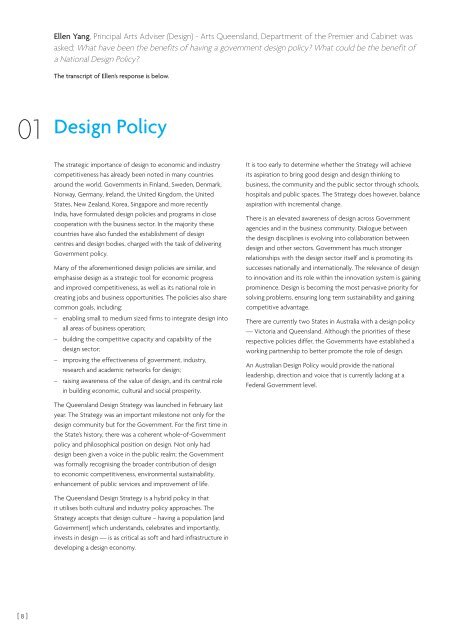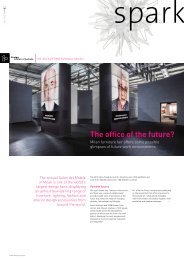Launch Report - Design Institute of Australia
Launch Report - Design Institute of Australia
Launch Report - Design Institute of Australia
You also want an ePaper? Increase the reach of your titles
YUMPU automatically turns print PDFs into web optimized ePapers that Google loves.
Ellen Yang, Principal Arts Adviser (<strong>Design</strong>) - Arts Queensland, Department <strong>of</strong> the Premier and Cabinet was<br />
asked: What have been the benefits <strong>of</strong> having a government design policy? What could be the benefit <strong>of</strong><br />
a National <strong>Design</strong> Policy?<br />
The transcript <strong>of</strong> Ellen’s response is below.<br />
01<br />
<strong>Design</strong> Policy<br />
The strategic importance <strong>of</strong> design to economic and industry<br />
competitiveness has already been noted in many countries<br />
around the world. Governments in Finland, Sweden, Denmark,<br />
Norway, Germany, Ireland, the United Kingdom, the United<br />
States, New Zealand, Korea, Singapore and more recently<br />
India, have formulated design policies and programs in close<br />
cooperation with the business sector. In the majority these<br />
countries have also funded the establishment <strong>of</strong> design<br />
centres and design bodies, charged with the task <strong>of</strong> delivering<br />
Government policy.<br />
Many <strong>of</strong> the aforementioned design policies are similar, and<br />
emphasise design as a strategic tool for economic progress<br />
and improved competitiveness, as well as its national role in<br />
creating jobs and business opportunities. The policies also share<br />
common goals, including:<br />
– enabling small to medium sized firms to integrate design into<br />
all areas <strong>of</strong> business operation;<br />
– building the competitive capacity and capability <strong>of</strong> the<br />
design sector;<br />
– improving the effectiveness <strong>of</strong> government, industry,<br />
research and academic networks for design;<br />
– raising awareness <strong>of</strong> the value <strong>of</strong> design, and its central role<br />
in building economic, cultural and social prosperity.<br />
It is too early to determine whether the Strategy will achieve<br />
its aspiration to bring good design and design thinking to<br />
business, the community and the public sector through schools,<br />
hospitals and public spaces. The Strategy does however, balance<br />
aspiration with incremental change.<br />
There is an elevated awareness <strong>of</strong> design across Government<br />
agencies and in the business community. Dialogue between<br />
the design disciplines is evolving into collaboration between<br />
design and other sectors. Government has much stronger<br />
relationships with the design sector itself and is promoting its<br />
successes nationally and internationally. The relevance <strong>of</strong> design<br />
to innovation and its role within the innovation system is gaining<br />
prominence. <strong>Design</strong> is becoming the most pervasive priority for<br />
solving problems, ensuring long term sustainability and gaining<br />
competitive advantage.<br />
There are currently two States in <strong>Australia</strong> with a design policy<br />
— Victoria and Queensland. Although the priorities <strong>of</strong> these<br />
respective policies differ, the Governments have established a<br />
working partnership to better promote the role <strong>of</strong> design.<br />
An <strong>Australia</strong>n <strong>Design</strong> Policy would provide the national<br />
leadership, direction and voice that is currently lacking at a<br />
Federal Government level.<br />
The Queensland <strong>Design</strong> Strategy was launched in February last<br />
year. The Strategy was an important milestone not only for the<br />
design community but for the Government. For the first time in<br />
the State’s history, there was a coherent whole-<strong>of</strong>-Government<br />
policy and philosophical position on design. Not only had<br />
design been given a voice in the public realm; the Government<br />
was formally recognising the broader contribution <strong>of</strong> design<br />
to economic competitiveness, environmental sustainability,<br />
enhancement <strong>of</strong> public services and improvement <strong>of</strong> life.<br />
The Queensland <strong>Design</strong> Strategy is a hybrid policy in that<br />
it utilises both cultural and industry policy approaches. The<br />
Strategy accepts that design culture – having a population (and<br />
Government) which understands, celebrates and importantly,<br />
invests in design — is as critical as s<strong>of</strong>t and hard infrastructure in<br />
developing a design economy.<br />
[ 8 ]














